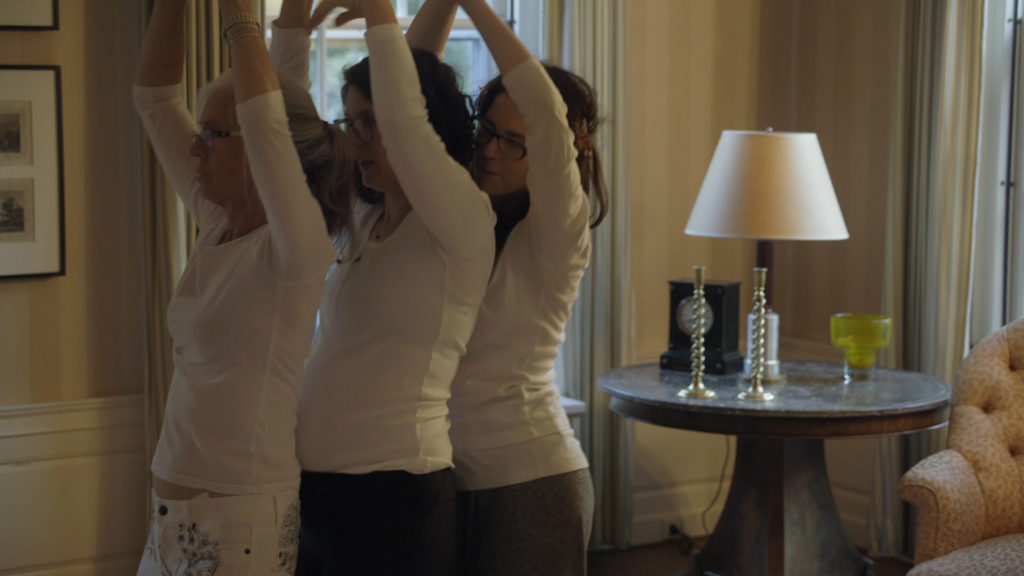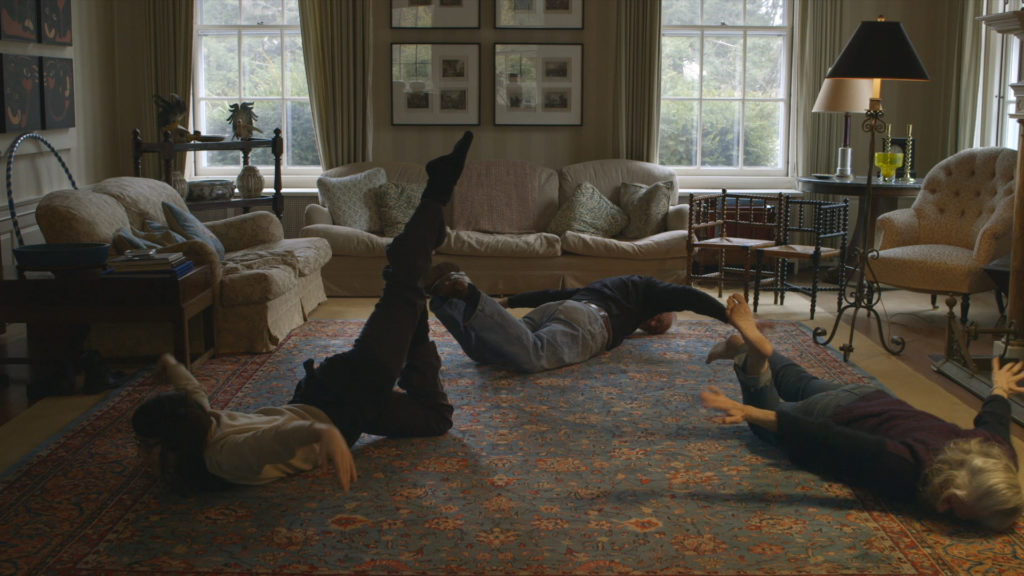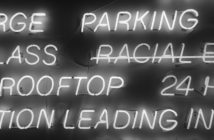Helen Singh-Miller is an artist and practitioner of the Feldenkrais Method of somatic education. Grand Union (2018), her new film incorporating elements of family life and postmodern dance, will be installed at the 33rd Bienal de São Paulo this fall. Drawing on somatic education and contemporary dance, her still and moving-image work explores the relationship between visual representation and embodied experience. Singh-Miller teaches TIME in Studio Foundation at MassArt and runs the Storefront for Somatic Practice in Cambridge, MA. We spoke recently about her new film.
Grand is the seen, the light, to me — grand are the sky and stars,
Grand is the earth, and grand are lasting time and space,
And grand their laws, so multiform, puzzling, evolutionary;
But grander far the unseen soul of me, comprehending, endowing all those… .
“Grand Is the Seen,” Walt Whitman
Robert Moeller: Grand Union specifically references a somewhat obscure experimental dance/movement collective. What exactly were they doing that fired your interest in their work?
Helen Singh-Miller: At first, it was reductionist, minimalist works from the 1960s that got my attention—more accessible pieces that entered the canon and museum circuit. As I got deeper into the archives, I started coming across this more expansive, jivey footage of the same dancers a decade on. Yvonne Rainer, Trisha Brown, and other equally talented and charismatic choreographers dancing and bouncing and shaking and tumbling around in gymnasiums, churches, and galleries with columns that got in the way or redirected the flow rather than simply falling in line with the geometry of a dance. In special collections reading rooms, I watched streaky VHS tapes of them paired up or gathered in small groups, dancing alone, or improvising as one big group of seven. The transitions were sometimes smooth, sometimes abrupt, but always felt somehow inevitable, and magical. Their use of the space and everything in it brought me back to my own fort-building days—and as it turns out, indeed many of the Grand Union members had young children at the time.
RM: You cast members of your family in the film. Besides recreating the active ties the original artists had to each other, was there a formal purpose to composing the film around their choreographed activities?
HSM: There’s this great documentation of Yvonne Rainer’s Continuous Project–Altered Daily (1969-70), which fed into what Grand Union was doing, that elegantly weaves the domestic into a bit of improvised choreography. The dancers are having what resembles a pillow fight and amounts to catching each other falling, one after the other, with pillows, in a rhythmic if unpredictable cascade.
Time is a crucial element of moving and learning to move, for anyone. Learning to walk, for example, a go-to postmodern dance move, involves hours of improvisation and collaboration—imitation, repetition, and variation—on the part of children and their caregivers. Only by attempting an infinite number of seemingly inconsequential movements does a child manage such identifiable feats as rolling over, crawling, walking, jumping on the bed, and so on; and only by deconstructing, recontextualizing, and in effect remaking these milestones of early childhood development does a choreographer produce a paradigmatic postmodern dance. I’m thinking of Trisha Brown’s Man Walking Down the Side of a Building (1970), Accumulation (1971), and Stream (1970). The latter two my family and I perform inside the house. Of Accumulation, Brown has said, “I decided I wanted to take my knowledge back into the working of movement. To start at the beginning….”[1]

Still from Grand Union (2018). Courtesy of Helen Singh-Miller.
Continuing with this element of language, or repertoire, I think that postmodern dance, propelled by a heightened sense of human movement’s grammar and syntax, further demonstrates our lifelong capacity to change. We can always revisit the early process of embodied learning to access and reorganize the basic building blocks of our behavior. Over the course of a postmodern dance or performance, not only movements but also movement styles, archetypes, and identities realign. The days the Grand Union spent dancing and sampling dance forms, changing hats, sharing weight, and riffing off one another in the early to mid-70s—it was this expanded field of experimentation I longed to inhabit with my family in making this film. It was, as dance ethnologist Irene Berger recalls of Grand Union, “The wit of them. The slowed down playful family feeling of them” that led me to make the connection.[2]
RM: These elegant, redemptive even, propositions you’ve pulled both from your work and your research would seem difficult to articulate to someone unfamiliar with the ideas you were exploring. How were you able to convey exactly what it is that you wanted from the performers, in this case, your family?
HSM: I wasn’t. Part of the pleasure of remaking something is the wager, I think. You have a serious hunch about how the original and the new material will resonate, or ricochet off one another. The more unlikely the potential alignment, the more compelling. Unpredictability can be freeing as well as forgiving. Did I communicate the nature and value of such a process to my family before and during filming? Probably not.
One primary tension in the film stems from my trying to impose upon people a movement practice whose express purpose is the activation of voluntary, self-originating inquiry. Curiosity is the central tenet of the Feldenkrais Method of somatic education, which I teach, and practices that postmodern dance spawned such as Contact Improvisation and Authentic Movement, argued by some to be quite therapeutic. External pressure, or begging, is not a viable source of motivation or engagement in this case.
Rather than persuading anyone of anything, postmodern dance as I introduced it mostly got in the way—of schedules, obligations, and desires—setting off real dynamics that might not have surfaced if addressed more directly or by consensus. At one point, my brother Charles asked me why I didn't ask them to dance the way they like to dance. Everyone in my family likes to dance, except my dad.... In the end, I guess my wish for the family to perform postmodern dance acted as a foil, throwing various responses and approaches to discomfort and difficulty into relief.
Watching my family run through Spanish Dance (thanks to Alex Auriema’s sensitive camerawork), I am touched by their resolve. As my mother, sister, and brothers shift their weight from side to side, opposite leg and arm to opposite leg and arm, they amplify the diagonals that allow us to be upright. In somatics speak, such cross-lateral movement—most pronounced in crawling and later immortalized in Renaissance contrapposto—activates development of the corpus callosum, a thick band of nerve fibers that coordinates motor, sensory, and cognitive performance between sides of the brain. Contralateral movement, the heart of Trisha Brown’s Spanish Dance, gets the right and left side of the body working together, including the eyes and ears, refining binocular vision and binaural hearing, so that the senses more fully access the environment and the body can move in a more connected way. Interestingly, the formative diagonal motion of crawling actually changes the shape of the child’s hip sockets and then, as somatics teacher Carla Hannaford tells us, “as the hips reshape, pulled inward and forward by the muscle function, they become stronger and better positioned to lift the body and to start forward propulsion. …[lifting]the child upward into standing and walking”... and dancing, we might add. [3]
RM: The science (or sciences) piece here is interesting. You talk about cognitive development and evolution, both improvisational and hard-wired, open to chance yet in many ways predetermined, where randomness is less chaotic than it seems. Is this part of the narrative, the storytelling process writ large?
HSM: I think this question is actually and wonderfully related to the difficulty around communication you brought up earlier. Perhaps the convergence of the avant-garde and the everyday is not just a coincidence, a matter of entropy or style, but akin to what Moshe Feldenkrais referred to as the “elusive obvious,” which we are always finding our way back to, for inspiration, in other words, the means to improvise.
In childhood, the freedom to try things out and see what works leads to discoveries about things we do more or less similarly—like crawling and walking—for which we are to some degree hard-wired. But improvisation is also the basis for totally whacked-out shit. It’s almost as if walking was our preparation for less predictable endeavors, a practice in improvising and being rewarded for doing so. And then it’s, well, a less sure-fire thing!
There are Feldenkrais lessons for investigating how you walk down the street every day, but there are also Feldenkrais lessons for investigating how you might walk backwards or sideways. Likewise, there are postmodern dances that pay attention to walking as if you are walking down the street and postmodern dances that entail walking on the wall or walking down a water tower. Somatics practitioners and dance choreographers are coming up with new lessons and dances every day.
Greater complexity does not always lead to more esoteric or inaccessible forms of experience but it does require patience. At least in the case of Grand Union, and postmodern dance more broadly, it would seem that the radical nature of the work is actually tied to hard-earned, day-in day-out discoveries about our shared humanity, our learning and growing and experimenting processes “writ large.”

Still from Grand Union (2018). Courtesy of Helen Singh-Miller.
RM: This sort of informed improvisation has its roots in 20th century popular culture, whether it was a comedic radio sketch or vaudeville, where “thinking on your feet” was intrinsic to the vitality of the performance. Given that you are re-improvising with utterly different cultural metrics at play, how has that impacted the dynamics of updating Grand Union’s original work?
HSM: Indeed, the whole structure of vaudeville shows seems to have been taken up as a model by the Grand Union—the performative hanging-around interspersed with more formalized skits and dance. As I understand it, this loosey goosey, “down” format and the surprise it could give rise to in the hands of “highly-tuned” artists was adopted in part to save Grand Union members from the potentially deadening preciousness of the more contained, highly contained, dances they’d made in the past. Yvonne Rainer has talked about the yearning for “content” and psychological depth that the early stuff left her and others feeling (although she has also been quick to point out that there was always more to Downtown dance than clever compositions performed in t-shirts).
Your question makes me think I could have done a screening of the original Grand Union tapes for my family after dinner before filming and asked my parents to identify some of the material being referenced. The Grand Union artists were kids in the 30s and 40s, more or less my parents’ generation. My ignorance of the history of vaudeville might be relevant, as it speaks to something I was working against and that any director, choreographer, or parent has to grapple with. How do you lay the groundwork for improvisation (much less a paradoxical attempt at re-improvisation)? How do you loosen people up, providing the necessary context while acknowledging that you can’t provide everything, or even close to it? How do you “hold the space”? Especially when you are talking about something as amorphous, however consciously and purposely, as the Grand Union.
One strategy, which is a Feldenkrais strategy, really, is introducing less. I excerpted passages from the hours of available Grand Union footage. This could be considered contrary to what Grand Union was all about but I think I found a link. While watching the Grand Union tapes, it became apparent that members would sometimes bring their own material to try out on the group. The transition from improvising to sharing, teaching, and learning choreography was pretty imperceptible, effectively ambiguous (part of its mastery and charm). So I tried to do just that. I took a piece of Grand Union and I brought it into the context of my family’s time together, to see what they would do with it. Specifically, I invited my parents to follow me, as Trisha Brown appears to have invited the Grand Union to follow her—on May 28, 1972 at the Joe LoGiudice Gallery at 59 Wooster Street in SoHo—in moving through some new choreography. I don’t even know what the piece that we performed is called, if it even is a piece, with a name or an existence outside the Grand Union performance I saw on tape. So yeah, it was easier to practice pieces with my family, along with short dances and movement experiments made by individual Grand Union members as well as other artists. The more improvised parts of our Grand Union grew out of territory that was familiar to us—biting comments, grooming, paperwork, Ping-Pong, football, and chess, or conversely, not even attempting to beat my dad at chess.

Still from Grand Union (2018). Courtesy of Helen Singh-Miller.
RM: Another layer is the house itself, where you’ve set the film. Juxtaposed with the gritty surroundings of the original performances you’ve drawn from, a rather stark contrast is presented as another strata of commentary.
HSM: Architects Peter Shelton and Lee Mindel, known for their Modernist/Minimalist Manhattan designs, updated the interior of this “American fantasy of a country house,” as Lee called it, in 1986, the year my parents bought it. I thought their savvy interpretation of the neo-federalist clapboard structure, built by a former hotelier, presented a funny kind of contrast if not exactly an alternative to what art historian Hal Foster has referred to as the “gray boxes” of affectless postmodern dance remade in museums today. [4]
A character in itself, there’s also this way in which the house acts as a metaphor for the experience of growing up in a big family or living in community. As in a hotel, you can hear what’s going on in the next room. Jerry MacDonald, the sound recordist, took great care to use a variety of microphones for each scene, often placing them outside the room in which “the action” was taking place. As a result, Ernst Karel, who did the final sound mix for the film, had a lot of material to work with in post-production. The sounds of doors closing, dishes clinking, and whistling, for example, contribute to a soundscape unlike the one you might hear in a museum gallery, where people get quiet to watch. Most interesting, perhaps, were the different room tones. Each room has a very distinct ambient sound or sonic atmosphere, which Ernst managed to bring out just enough, not too much. They say young kids find comfort in the knowledge that the adults are just around the corner if doing their own thing. I have good memories of doing my thing alongside others doing the same—both in the context of domestic life and art making—and I’m glad we were able to capture some of this kind of simultaneity in the film.
RM: The overlay of using film to capture the performances in Grand Union adds another layer of choreography and artifice to unpacking the work of the original artists. How would you approach these re-improvised moments in a “live” context? A performance, say? What would change?
HSM: Well, first I think I’d have to capture more performances on film. I was new to film and video, newer than I was to dance, when I started on this project, and I don’t feel I did justice to the role of documentary or cinema in the piece. I mean, there are lots of pitfalls when it comes to dance on film, and though I avoided a good degree of dramatic flourish, I certainly didn’t learn enough from the original Grand Union videographers. Nor did I draw much for the filming from the formal elements of the postmodern choreography, rich with reference to still and moving picture making.

Still from Grand Union (2018). Courtesy of Helen Singh-Miller.
I couldn’t even decide, with any confidence, how much handheld camerawork we were or weren’t going to experiment with (none) until the last minute, which means that the people helping me to film the dancing were also fairly in the dark, and made more of the situation than I could have imagined. Their empathy and restraint was crucial. One thing we did manage to get down before the shoot was the light! I followed the sun around the house for days and I think that’s apparent in the emphasis on appearance and “the visible world” in the work.
Your question makes me reflect on how video would have been to Grand Union what film and photography were to other instances of postmodern dance. The more explicitly formal, paired down dances were often very photogenic, and endlessly photographed. The Grand Union project was, perhaps, harder to see, harder to predict or repeat, and harder to catch, no doubt—although the increasingly portable equipment must have been revolutionary in this regard. I would love to have more consciously engaged these related chapters in postmodern dance at the level of media culture, activating the aesthetic and perceptual complexity of human movement, and still would.




